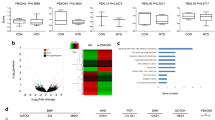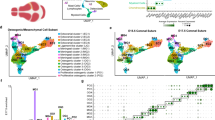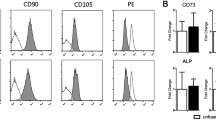Abstract
Craniosynostosis is a developmental disorder of the skull arising from premature bony fusion of cranial sutures, the sites of skull bone growth. In a recent gene microarray study, we demonstrated that retinol-binding protein 4 (RBP4) was the most highly downregulated gene in suture tissue during the pathological process of premature bony fusion. To gain insight into the function of RBP4 in cranial sutures, we analysed primary cells cultured from human cranial suture mesenchyme. These cells express RBP4 but not CRBP1, cellular retinol-binding protein 1, the typical cytoplasmic retinol storage protein. Using flow cytometry, we showed that suture mesenchymal cells express the RBP4 receptor, STRA6, on the cell surface. In a cell culture model of cranial osteogenesis, we found that RBP4 was significantly downregulated during mineralization, analogous to its decrease in pathological suture fusion. We found that cranial suture cells do not secrete detectable levels of RBP4, suggesting that it acts in a cell-autonomous manner. High-resolution confocal microscopy with a panel of antibody markers of cytoplasmic organelles demonstrated that RBP4 was present in several hundred cytoplasmic vesicles of about 300 nm in diameter which, in large part, were conspicuously distinct from the ER, the Golgi and endosomes of the endocytic pathway. We speculate that in suture mesenchymal cells, endogenous RBP4 receives retinol from STRA6 and the RBP4-retinol complex is stored in vesicles until needed for conversion to retinoic acid in the process of osteogenesis. This study extends the role of RBP4 beyond that of a serum transporter of retinol and implicates a broader role in osteogenesis.








Similar content being viewed by others
Abbreviations
- CANX:
-
Calnexin
- CRBP1:
-
Cellular retinol-binding protein 1
- EEA1:
-
Early endosomal antigen 1
- ER:
-
Endoplasmic reticulum
- FGFR:
-
Fibroblast growth factor receptor
- LAMP1:
-
Lysosome-associated membrane protein 1
- LRAT:
-
Lecithin retinol acyltransferase
- OG:
-
Osteogenic media
- RBP4:
-
Retinol-binding protein 4
- STRA6:
-
Stimulated by retinoic acid clone # 6
References
Anderson PJ, Cox TC, Roscioli T, Elakis G, Smithers L, David DJ, Powell BC (2007) Somatic FGFR and TWIST mutations are not a common cause of isolated non-syndromic single suture craniosynostosis. J Craniofac Surg 18:312–314
Bloom GS, Brashear TA (1989) A novel 58-kDa protein associates with the Golgi apparatus and microtubules. J Biol Chem 264(27):16083–16092
Broch M, Ramirez R, Auguet MT, Alcaide MJ, Aguilar C, Garcia-Espana A, Richart C (2010) Macrophages are novel sites of expression and regulation of retinol binding protein-4 (RBP4). Physiol Res 59(2):299–303
Choong PF, Martin TJ, Ng KW (1993) Effects of ascorbic acid, calcitriol, and retinoic acid on the differentiation of preosteoblasts. J Orthop Res 11(5):638–647
Christensen EI, Moskaug JO, Vorum H, Jacobsen C, Gundersen TE, Nykjaer A, Blomhoff R, Willnow TE, Moestrup SK (1999) Evidence for an essential role of megalin in transepithelial transport of retinol. J Am Soc Nephrol 10(4):685–695
Cornell CT, Kiosses WB, Harkins S, Whitton JL (2006) Inhibition of protein trafficking by coxsackievirus b3: multiple viral proteins target a single organelle. J Virol 80(13):6637–6647
Coussens AK, Wilkinson CR, Hughes IP, Morris CP, van Daal A, Anderson PJ, Powell BC (2007) Unravelling the molecular control of calvarial suture morphogenesis in children with craniosynostosis. BMC Genomics 8:458. doi:10.1186/1471-2164-1188-1458
Coussens AK, Wilkinson CR, Hughes IP, Powell BC, Anderson PJ, van Daal A (2008) Identification of genes differentially expressed by prematurely fused human sutures using a novel in vivo–in vitro approach. Differentiation 76:531–545
Das S, Pellett PE (2011) Spatial relationships between markers for secretory and endosomal machinery in human cytomegalovirus-infected cells versus those in uninfected cells. J Virol 85(12):5864–5879
De Pollack C, Renier D, Hott M, Marie PJ (1996) Increased bone formation and osteoblastic cell phenotype in premature cranial suture ossification (craniosynostosis). J Bone Miner Res 11(3):401–407
Goodman DS (1984) Plasma retinol binding protein. In: Sporn MB, Roberts AB, Goodman DS (eds) The Retinoids, vol 2. Academic Press, New York, pp 42–88
Gray TL, Casey T, Selva D, Anderson PJ, David DJ (2005) Ophthalmic sequelae of Crouzon syndrome. Ophthalmol 112(6):1129–1134
Ishida S, Kinoshita T, Sugawara N, Yamashita T, Koike K (2003) Serum inhibitors for human mast cell growth: possible role of retinol. Allergy 58(10):1044–1052
James AW, Levi B, Xu Y, Carre AL, Longaker MT (2010) Retinoic acid enhances osteogenesis in cranial suture-derived mesenchymal cells: potential mechanisms of retinoid-induced craniosynostosis. Plast Reconstr Surg 125(5):1352–1361
Kameko M, Ota H, Ishii K, Nakayama J, Katsuyama T, Kanai M, Tsutsumi Y (1992) Distribution of retinol-binding protein in the human digestive tract. Virchows Arch B Cell Pathol Incl Mol Pathol 61(5):315–322
Kawaguchi R, Yu J, Honda J, Hu J, Whitelegge J, Ping P, Wiita P, Bok D, Sun H (2007) A membrane receptor for retinol binding protein mediates cellular uptake of vitamin A. Science 315(5813):820–825
Kawaguchi R, Yu J, Ter-Stepanian M, Zhong M, Cheng G, Yuan Q, Jin M, Travis GH, Ong D, Sun H (2011) Receptor-mediated cellular uptake mechanism that couples to intracellular storage. ACS Chem Biol 6(10):1041–1051
Kawaguchi R, Zhong M, Kassai M, Ter-Stepanian M, Sun H (2012) STRA6-Catalyzed Vitamin A Influx, Efflux, and Exchange. J Membr Biol. Epub 2012/07/21. doi:10.1007/s00232-012-9463-1
Kawashima-Ohya Y, Kuruta Y, Yan W, Kawamoto T, Noshiro M, Kato Y (1999) Retinol-binding protein is produced by rabbit chondrocytes and responds to parathyroid hormone (PTH)/PTH-related peptide-cyclic adenosine monophosphate pathway. Endocrinology 140(3):1075–1081
Khong JJ, Anderson P, Gray TL, Hammerton M, Selva D, David D (2006) Ophthalmic findings in Apert’s syndrome after craniofacial surgery: twenty-nine years’ experience. Ophthalmol 113(2):347–352
Komatsu Y, Watakabe A, Hashikawa T, Tochitani S, Yamamori T (2005) Retinol-binding protein gene is highly expressed in higher-order association areas of the primate neocortex. Cereb Cortex 15(1):96–108
Laue K, Pogoda HM, Daniel PB, van Haeringen A, Alanay Y, von Ameln S, Rachwalski M, Morgan T, Gray MJ, Breuning MH, Sawyer GM, Sutherland-Smith AJ, Nikkels PG, Kubisch C, Bloch W, Wollnik B, Hammerschmidt M, Robertson SP (2011) Craniosynostosis and multiple skeletal anomalies in humans and zebrafish result from a defect in the localized degradation of retinoic acid. Am J Hum Genet 89(5):595–606
Lieu ZZ, Gleeson PA (2011) Endosome-to-Golgi transport pathways in physiological processes. Histol Histopathol 26(3):395–408
Livak KJ, Schmittgen TD (2001) Analysis of relative gene expression data using real-time quantitative PCR and the 2(-Delta Delta C(T)) Method. Methods 25(4):402–408
Makover A, Soprano DR, Wyatt ML, Goodman DS (1989) Localization of retinol-binding protein messenger RNA in the rat kidney and in perinephric fat tissue. J Lipid Res 30(2):171–180
Marinari L, Lenich CM, Ross AC (1987) Production and secretion of retinol-binding protein by a human hepatoma cell line, HepG2. J Lipid Res 28(8):941–948
Matt N, Schmidt CK, Dupe V, Dennefeld C, Nau H, Chambon P, Mark M, Ghyselinck NB (2005) Contribution of cellular retinol-binding protein type 1 to retinol metabolism during mouse development. Dev Dyn 233(1):167–176
Mills JP, Furr HC, Tanumihardjo SA (2008) Retinol to retinol-binding protein (RBP) is low in obese adults due to elevated apo-RBP. Exp Biol Med (Maywood) 233(10):1255–1261
Moise AR, Golczak M, Imanishi Y, Palczewski K (2007) Topology and membrane association of lecithin: retinol acyltransferase. J Biol Chem 282(3):2081–2090
Napoli JL (1999) Interactions of retinoid binding proteins and enzymes in retinoid metabolism. Biochim Biophys Acta 1440(2–3):139–162
Napoli JL (2012) Physiological insights into all-trans-retinoic acid biosynthesis. Biochim Biophys Acta 1821(1):152–167
Park CK, Ishimi Y, Ohmura M, Yamaguchi M, Ikegami S (1997) Vitamin A and carotenoids stimulate differentiation of mouse osteoblastic cells. J Nutr Sci Vitaminol (Tokyo) 43(3):281–296
Quadro L, Blaner WS, Hamberger L, Novikoff PM, Vogel S, Piantedosi R, Gottesman ME, Colantuoni V (2004) The role of extrahepatic retinol binding protein in the mobilization of retinoid stores. J Lipid Res 45(11):1975–1982
Sato M, Amemiya K, Hayakawa S, Munakata H (2008) Subcellular localization of human heparanase and its alternative splice variant in COS-7 cells. Cell Biochem Funct 26(6):676–683
Senoo H, Stang E, Nilsson A, Kindberg GM, Berg T, Roos N, Norum KR, Blomhoff R (1990) Internalization of retinol-binding protein in parenchymal and stellate cells of rat liver. J Lipid Res 31(7):1229–1239
Shingleton JL, Skinner MK, Ong DE (1989) Characteristics of retinol accumulation from serum retinol-binding protein by cultured Sertoli cells. Biochemistry 28(25):9641–9647
Song HM, Nacamuli RP, Xia W, Bari AS, Shi YY, Fang TD, Longaker MT (2005) High-dose retinoic acid modulates rat calvarial osteoblast biology. J Cell Physiol 202(1):255–262
Soprano DR, Soprano KJ, Goodman DS (1986) Retinol-binding protein messenger RNA levels in the liver and in extrahepatic tissues of the rat. J Lipid Res 27(2):166–171
Suhara A, Kato M, Kanai M (1990) Ultrastructural localization of plasma retinol-binding protein in rat liver. J Lipid Res 31(9):1669–1681
Theodosiou M, Laudet V, Schubert M (2010) From carrot to clinic: an overview of the retinoic acid signaling pathway. Cell Mol Life Sci 67(9):1423–1445
Usuda N, Kameko M, Kanai M, Nagata T (1983) Immunocytochemical demonstration of retinol-binding protein in the lysosomes of the proximal tubules of the human kidney. Histochemistry 78(4):487–490
Verroust PJ, Christensen EI (2002) Megalin and cubilin—the story of two multipurpose receptors unfolds. Nephrol Dial Transplant 17(11):1867–1871
Wada I, Rindress D, Cameron PH, Ou WJ, Doherty JJ 2nd, Louvard D, Bell AW, Dignard D, Thomas DY, Bergeron JJ (1991) SSR alpha and associated calnexin are major calcium binding proteins of the endoplasmic reticulum membrane. J Biol Chem 266(29):19599–19610
Weston AD, Hoffman LM, Underhill TM (2003) Revisiting the role of retinoid signaling in skeletal development. Birth Defects Res C Embryo Today 69(2):156–173
Wilkie AO, Morriss-Kay GM (2001) Genetics of craniofacial development and malformation. Nat Rev Genet 2(6):458–468
Yao-Borengasser A, Varma V, Bodles AM, Rasouli N, Phanavanh B, Lee MJ, Starks T, Kern LM, Spencer HJ 3rd, Rashidi AA, McGehee RE Jr, Fried SK, Kern PA (2007) Retinol binding protein 4 expression in humans: relationship to insulin resistance, inflammation, and response to pioglitazone. J Clin Endocrinol Metab 92(7):2590–2597
Yip JE, Kokich VG, Shepard TH (1980) The effect of high doses of retinoic acid on prenatal craniofacial development in Macaca nemestrina. Teratology 21(1):29–38
Zhou H, Hammonds RG Jr, Findlay DM, Fuller PJ, Martin TJ, Ng KW (1991) Retinoic acid modulation of mRNA levels in malignant, nontransformed, and immortalized osteoblasts. J Bone Miner Res 6(7):767–777
Acknowledgments
Funding for this research was provided by NHMRC and the Australian Cranio-Maxillo Facial Foundation. Ms Leitch was supported by a scholarship from the University of Adelaide and Hansen Yuncken, Australian Rotary Health. Huh7 cells were a gift of Prof Eric Gowans, University of Adelaide, South Australia. We thank Dr Yeesim Khew-Goodall and Dr Leila Belle of the Centre for Cancer Biology, SA Pathology, Adelaide, for gifts of the EEA1, Rab9, Rab11 and LAMP1 antibodies. We thank Dr Randall Grose (Women’s and Children’s Health Research Institute) for assistance with flow cytometry and Dr Ghafar Sarvestani, Hanson Institute for Medical Research, SA Pathology, Adelaide, and Ms Hang Leong (Women’s and Children’s Health Research Institute) for assistance with confocal microscopy.
Author information
Authors and Affiliations
Corresponding author
Additional information
V. D. Leitch and P. P. Dwivedi contributed equally.
P. J. Anderson and B. C. Powell are joint senior authors.
Rights and permissions
About this article
Cite this article
Leitch, V.D., Dwivedi, P.P., Anderson, P.J. et al. Retinol-binding protein 4 downregulation during osteogenesis and its localization to non-endocytic vesicles in human cranial suture mesenchymal cells suggest a novel tissue function. Histochem Cell Biol 139, 75–87 (2013). https://doi.org/10.1007/s00418-012-1011-7
Accepted:
Published:
Issue Date:
DOI: https://doi.org/10.1007/s00418-012-1011-7




